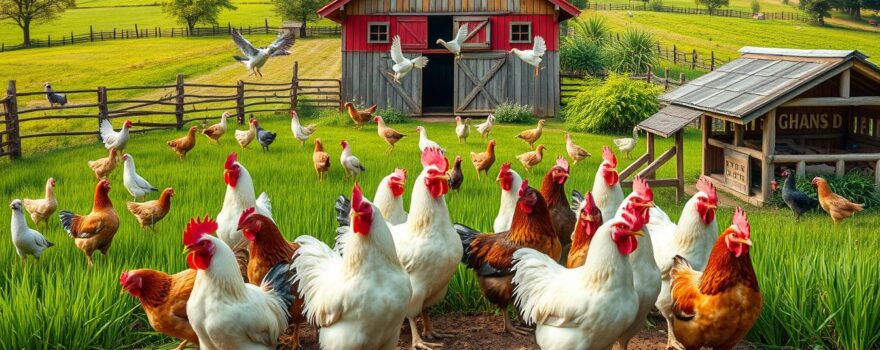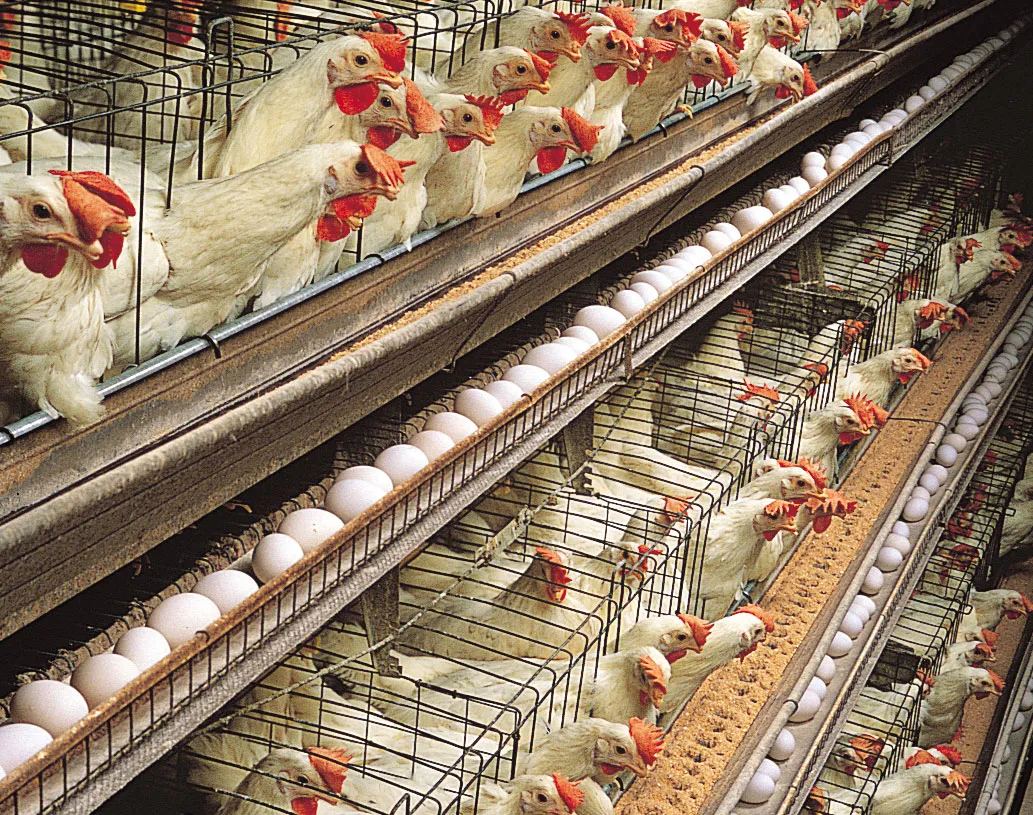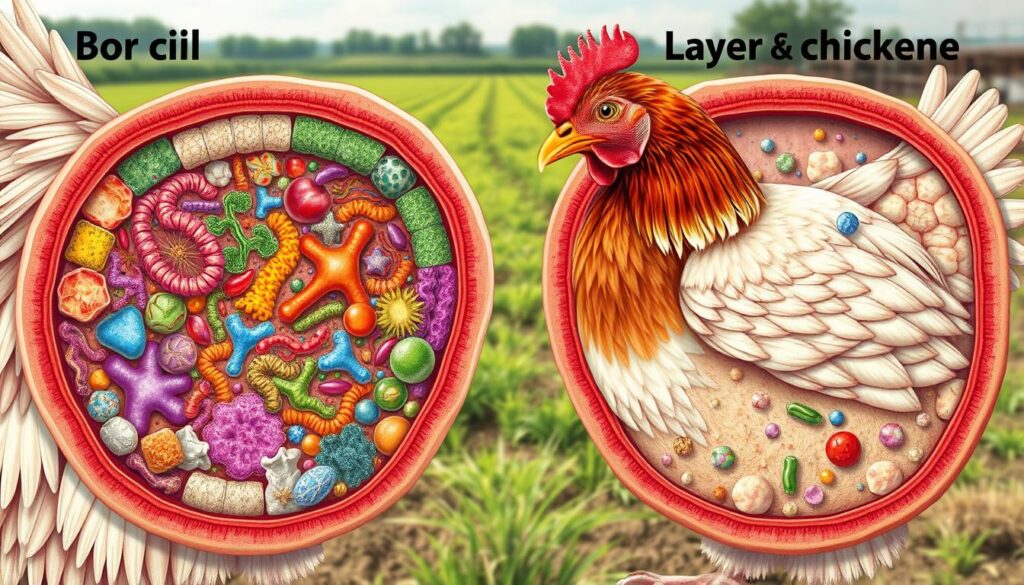
Broiler chickens are a big part of our food worldwide. They show big differences in how they are raised, eaten, and made in various places and cultures. This article looks into the ways chickens are farmed and how people eat them, from choosing breeds to how they are killed and the quality of their meat. Knowing these differences helps us tackle problems, make farming better, and meet what people want to eat more.
Key Takeaways
- Broiler chickens show big differences in farming, eating, and making in different places and cultures.
- Looking into these differences is key to solving problems, making farming better, and meeting what people want to eat.
- Things like choosing breeds, feeding, killing methods, and meat quality can change a lot.
- Understanding these differences is vital for the chicken industry to grow and succeed worldwide.
- This article gives a detailed look at how chickens differ in regions and cultures, setting the stage for more exploration.
Introduction to Broiler Chicken Production
Broiler chickens are a special type of chicken bred for fast growth and efficient eating. They have been improved over centuries through careful breeding. The Southeast Asian Red Junglefowl is their main ancestor. Breeds like the Cornish and Brahma also got genes from the Grey Junglefowl of India and the Sri Lanka Junglefowl.
Broiler Chicken Breeds and Their Origins
Over time, farmers have focused on traits like fast growth and good feed use. This has led to big changes in broiler chickens. They now grow much bigger and use less food than before.
Genetic Selection for Growth and Feed Efficiency
Modern broiler chickens grow fast and use food well thanks to breeding. They now reach market weight in just 35 days, eating only 3.3 kg of feed. This shows how the industry is working to make broilers better and more sustainable.
| Metric | 1957 | 2001 | Improvement |
|---|---|---|---|
| Growth | 1.8 kg | 2.5 kg | 39% increase |
| Feed Conversion Ratio | 2.4 | 1.9 | 21% reduction |
| Livability | 85% | 95% | 12% increase |
The table shows how much better broilers are now. They grow faster, use less food, and live longer thanks to better breeding and nutrition.
Regional Variations in Broiler Farming Practices
Broiler chicken farming changes a lot from one place to another. This is because of different weather, culture, and resources. The main differences are in how birds are kept, how the environment is controlled, and how farms are managed.
Broiler Housing and Environmental Conditions
In hot places, broiler houses focus on keeping cool and well-ventilated. In cooler areas, they focus on keeping warm and insulated. What food is used, how clean the water is, and disease risks also play a big role.
- Broiler houses in tropical regions emphasize ventilation and cooling to manage high temperatures.
- Broiler houses in temperate climates prioritize insulation and heating to maintain optimal environmental conditions.
- Regional variations in feed ingredients, water quality, and disease pressures impact broiler farming practices and production efficiency.
In hot, humid areas, houses have big windows, fans, and coolers to keep birds healthy. In cold places, houses are well-insulated, heated, and ventilated to protect the chickens.
The type of food and water available also affects farming. Places with lots of energy-rich foods might use them to grow birds fast. Areas with less might use cheaper options.
“Understanding the regional variations in broiler farming practices is crucial for optimizing production, animal welfare, and ultimately, the quality and safety of broiler meat.”
By adjusting housing, controls, and management to fit local needs, farmers can make their farms better. This ensures birds are healthy and meets the needs of people everywhere.
Cultural Influences on Broiler Chicken Consumption
Broiler chicken eating habits vary worldwide due to cultural traditions. Different regions have their own ways of cooking and using broiler chickens in meals. Each culture has its own favorite cooking methods and recipes.
Traditional Cooking Methods and Recipes
In some places, people like to grill or roast broiler chickens. Others prefer frying to get a crispy, tasty dish. Traditional recipes often use special spices and flavors that are part of the local food history.
These cultural tastes not only influence how broiler chicken is made but also how it’s seen and wanted by people. Knowing about these traditions is key for the industry to meet the needs of different markets around the world.
| Region | Traditional Chicken Cooking Method | Signature Recipes |
|---|---|---|
| Southern United States | Fried chicken | Fried chicken, chicken and waffles |
| India | Tandoor grilling, curries | Tandoori chicken, butter chicken |
| Thailand | Stir-frying, grilling | Gai yang (grilled chicken), khao man gai (chicken rice) |
| Mexico | Roasting, braising | Pollo en mole (chicken in mole sauce), tinga de pollo (shredded chicken in tomato sauce) |
These cultural influences not only shape the final broiler chicken dish but also consumer perceptions, acceptance, and demand for certain broiler chicken products. Understanding the diverse culinary traditions surrounding broiler chicken consumption is crucial for the industry to cater to the preferences of various global markets.

“The way a chicken is cooked speaks volumes about the culture and traditions of a region.”
Pathogenic Risks: Salmonella Serovars in Broiler Chickens
Broiler chickens can carry different Salmonella serovars, which are a food safety risk. A study from 2016 to 2020 found that Salmonella serovars vary by region in the U.S. The Atlantic, Southeast, and South Central regions have more of certain serovars. Knowing this helps in making better food safety plans for broiler chickens.
The USDA reports over 1.35 million salmonellosis cases each year. This leads to 23,000 hospitalizations and 450 deaths, costing $3.7 billion. Chicken is the main cause of these outbreaks, with a rise in cases from 2016 to 2021. Yet, the chicken industry has cut Salmonella in chicken parts by more than half.
The most common Salmonella types in chicken are Kentucky, Enteritidis, and Typhimurium. The U.S. poultry industry has made progress in reducing Salmonella as chicken moves through processing stages.
“Understanding regional patterns in Salmonella contamination is crucial for developing targeted intervention strategies to improve broiler chicken food safety.”
Research shows that some Salmonella tests might miss certain serovars. But, new methods like CRISPR-SeroSeq help find and count all serovars. This helps in controlling Salmonella in chicken farms and processing plants.
How Broiler Chickens Differ Across Regions and Cultures
Broiler chickens are a key food source worldwide. They vary a lot in how they’re farmed, eaten, and produced. These differences come from local weather, resources, traditions, and what people like to eat. It’s important to understand these differences to make the broiler chicken sector better and meet new consumer needs.
In the United States, people now prefer chicken pieces and processed foods more than whole birds. This change is due to how families live and the need for quick, easy meals. But in Asia and Latin America, whole carcasses are still the favorite, influenced by local customs and beliefs.
How chickens are bred has changed too. Breeders focus on growth, meat quality, and how much food they need. This is true for both male and female chickens, but in different ways.
The broiler chicken industry has made big strides globally. There are about 22.7 billion chickens worldwide, and chicken meat is more popular than ever. But, breeding has made chickens less diverse, losing half or more of their genetic variety compared to older breeds.
The differences in how broiler chickens are raised and eaten show the industry’s complexity. It’s key to understand and adjust to these differences to keep the industry sustainable, profitable, and able to meet the needs of people everywhere.
“Broiler chickens have experienced a steady increase in growth rate since 1964, with genetics and breeding contributing to approximately 80 to 90% of production improvements in the industry.”
Broiler vs. Layer: Comparison of Caecal Microbiota
Studies have found big differences in the gut bacteria of broiler and layer chickens. Even when raised the same way, their gut bacteria are quite different. Broilers, bred for fast growth, have a unique mix of bacteria compared to layer hens. Layers have a lot of Proteobacteria, especially Escherichia coli, which was a surprise.
Impact of Genetic Selection on Gut Microbiome
The differences in gut bacteria suggest genetics play a big role in how different poultry strains grow. Early life inoculation with adult-derived microbiota accelerates maturation of intestinal microbiota and enhances NK cell activation in broiler chickens (Meijerink et al., 2020).
Researchers found that microbiota transplantation in day-old broiler chickens ameliorates necrotic enteritis via modulation of the intestinal microbiota and host immune responses (Zaytsoff et al., 2022). This shows how important gut bacteria are for broiler chicken health and growth.

“The intestinal microbiota of an individual chicken may consist of between 200 and 350 different bacterial species.”
Studies also show that host genotype in chickens has been shown to influence the intestinal microbiota (Bindari and Gerber, 2022). Things like litter type and diet can change the bacteria in chickens’ guts too.
Feed Formulations and Growth Rates Across Regions
Broiler chicken production varies a lot around the world. This is due to different feed costs, environmental conditions, and cultural tastes. Knowing these differences helps improve broiler nutrition and meet global demands.
In the last 20 years, broilers have grown much faster thanks to genetics. By 2034, they will reach 2.34 kg in just 29 days. This fast growth has also made them more efficient, needing less food to grow.
Studying the genetics of broilers is key. A study in Brazil found that body weight and fat content are most heritable. This knowledge helps breed better broilers and improve feed.
An experiment in Ladakh, India, showed the best broiler strains for high altitudes. The RIR cross-bred strain grew better and used less feed. Probiotics also helped with health issues, showing the value of tailored feed.
As the broiler industry grows, understanding regional differences is vital. It ensures sustainable and efficient production worldwide. For more information, visit here.
| Parameter | 1957 | Today |
|---|---|---|
| Body weight (42 days) | 586 g | 2,900 g |
| Feed Conversion Ratio (FCR) | 2.8 | Under 1.70 |
“Genetic improvements and breeding contribute to around 80-90% of the observed production enhancements in the broiler industry.”
Slaughter and Processing Methods: Regional Differences
Broiler chicken slaughter and processing vary by region. This is due to cultural, religious, and regulatory factors. Some places focus on fast, mechanized methods, while others stick to traditional ways to meet consumer tastes.
Halal and Kosher Slaughtering Practices
In some areas, like Saudi Arabia, Halal slaughtering is key. It follows Islamic dietary laws. Kosher methods are also important in Jewish communities.
These methods affect broiler meat quality and the supply chain. Research is ongoing to compare these methods and their impact on meat.
Poultry slaughter rules vary worldwide. In the US, the USDA checks for cleanliness and handling. Most US facilities use low-voltage stunning to make birds unconscious before slaughter.
In contrast, the EU requires high-voltage stunning, which is fatal. Saudi Arabia uses non-stun Halal methods, leading to more blood loss but better meat quality and safety.
These differences show how markets adapt to their unique settings. This shapes the quality and features of broiler chicken products.
Broiler Chicken Meat Quality and Nutritional Value
Broiler chicken meat is packed with high-quality protein, vitamins, and minerals. But, its nutritional value and quality can change based on several factors. These include the chicken’s breed, what it eats, and how it’s raised.
Genetic selection is key in making broiler meat better. Traits like meat quality can vary from 0.35 to 0.81. The meat’s color is also important, influenced by genetics, diet, and how it’s processed.
Meat texture and tenderness matter a lot to consumers. Factors like muscle state and slaughtering methods play a big role. Knowing how meat quality varies by region helps meet consumer needs and ensure safety.
By keeping up with research and trends, producers can improve broiler chicken meat quality. This makes it more appealing to different markets and cultures.